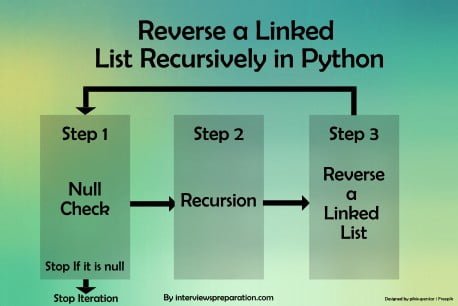Reverse a linked list recursively in Python is often asked in interviews. Let’s delve into programming to invert, flip, or reverse a linked list iteratively in Python.
Welcome back, visitor. In this blog post, I’m going to find inverse of a linked list recursively in Python. Programming flip linked list is commonly asked in interviews for intermediate level preparation. Additionally, mirror a linked list sequentially is available on LeetCode, Code Ninja, Code Studio, GFG practice platforms.
FREE : If you’re a new visitor preparing for an interview and need help or want to request a new question, you can use the form on the right side to ask your question. It’s free and doesn’t require signing in. Alternatively, you can ask in our Quora space, which is also free, and you’ll receive a response within 24 hours. Go ahead and check it out! do check Function Overloading in C++ and Two Sum LeetCode solution in C#
Table of Contents
How can you invert a linked list?
The answer is simple: you just need to update the next pointer of the current node to point to its previous node. By doing that, you can recursively invert the linked list.
Do not worry; I will explain in depth how to achieve ‘inverse a linked list recursively in Python.’ I hope you understand the basic concept, right? If not, let me explain it through an animation. Please check the animation below to see how it works.
Program to Reverse a linked list in Python
I’m going to break down the process of opposite a linked list repetitively in python into four steps. This way, you can understand it better and make any necessary changes if required.

Step 1 : Null Checks in a linked list
The first step is to check for null. If our next linked list node is null or the linked list node itself is null, then we break the recursion and return the current head.
def reverseList(self, head: ListNode) -> ListNode:
# program by interviewspreparation.com
if not head or not head.next:
return headStep 2 : Recursively reverse a linked list
In the second step, I am going to integrate the logic for sequentially inverting a linked list. I will create a local variable named ‘reversed_head’ and assign ‘self.reverseList(head.next),’ which means we assign the current linked list’s next node to be recursively inverted.
def reverseList(self, head: ListNode) -> ListNode:
# solution by interviewspreparation.com
if not head or not head.next:
return head
reversed_head = self.reverseList(head.next)
In other words, the function calls itself with the next linked list node. Therefore, we iterate through all of the linked list’s next node members. Understood?
Step 3 : Update Pointer To Previous Node
In the previous step, I have already implemented recursion. Now, we need to update the pointer value. keep your focus here because I am going to implement inverse a linked list logic.
In the first step, I have already implemented null checks for both the current node and the current next node. Therefore, we must have the next to next node. Hence, I am going to assign ‘head.next.next’ to the current ‘head’ and set null to ‘head.next’.
def reverseList(self, head: ListNode) -> ListNode:
# program by interviewspreparation.com
if not head or not head.next:
return head
reversed_head = self.reverseList(head.next)
head.next.next = head
head.next = NoneHard to understand ? do check video animation.
Step 4 : Return
In the final step, we simply need to return ‘reversed_head’ because we have already updated the pointer in the preceding step
def reverseList(self, head: ListNode) -> ListNode:
# solution by interviewspreparation.com
if not head or not head.next:
return head
reversed_head = self.reverseList(head.next)
head.next.next = head
head.next = None
return reversed_headSummarizing reverse a linked list recursively program
To understand reverse linked list, think of it as the process of flipping or inverting the order of elements in a linked list. This operation is fundamental in data structures and algorithms. There are various methods to accomplish this, including iterative, recursive, or through paired reversal. Linked lists come in different types, such as singly linked lists, doubly linked lists, circular linked lists, and sorted linked lists. Inverting a linked list in pairs involves swapping adjacent elements, while recursive inversion employs a function calling itself with the next linked list node. Reversing a doubly linked list requires adjusting both the next and previous pointers. Additionally, stacks can be reversed using pop and push operations. Achieving a reverse in less than O(n) time complexity is challenging but possible with certain optimizations. Popular platforms like LeetCode, GeeksforGeeks, and Code Studio offer practice problems related to linked list reversal. Stack Overflow hosts queries regarding the best approaches for inverting linked lists in various programming languages such as Java and C.
